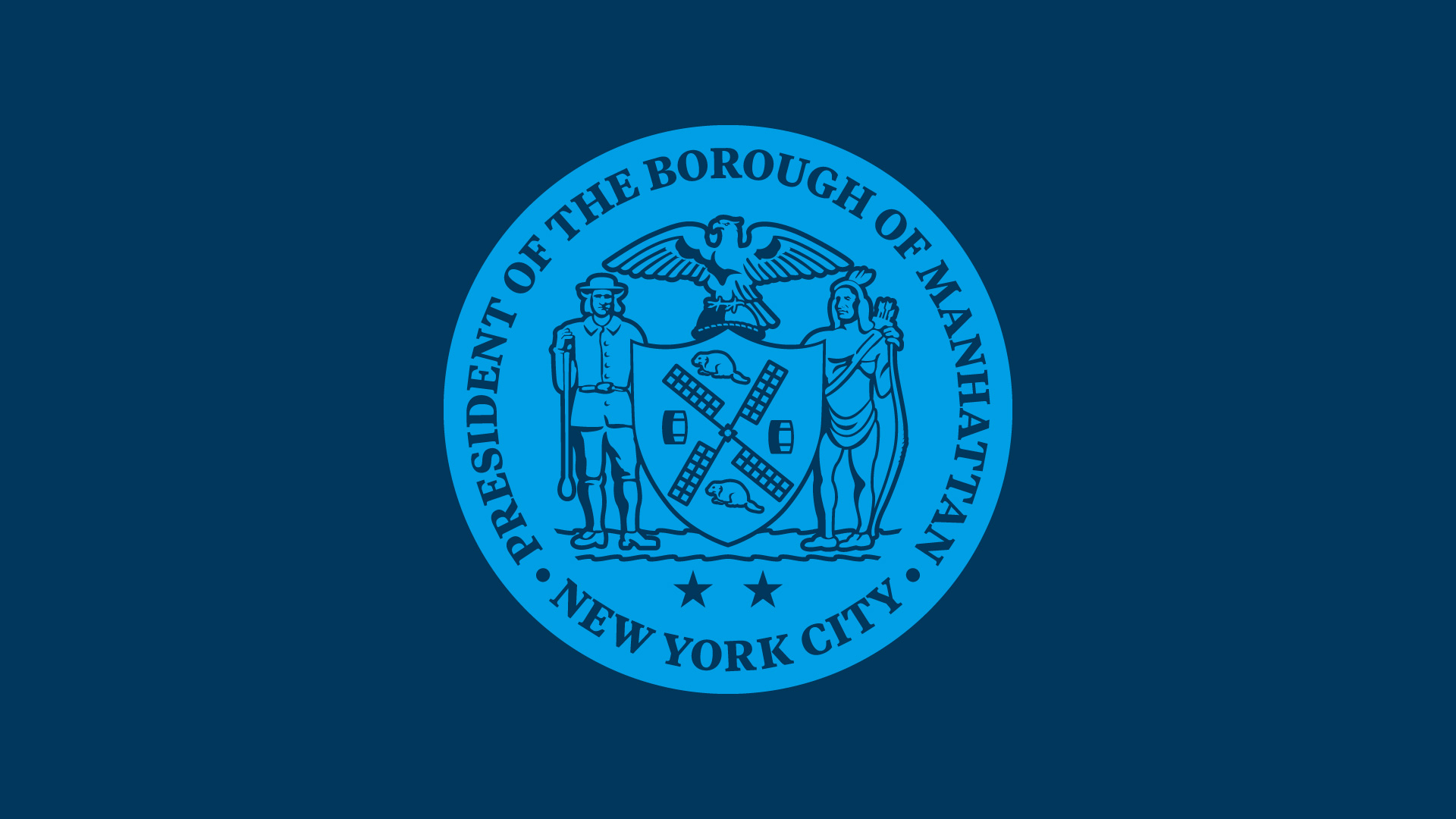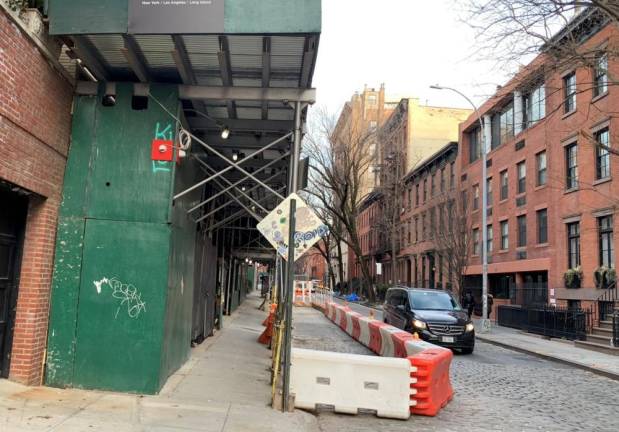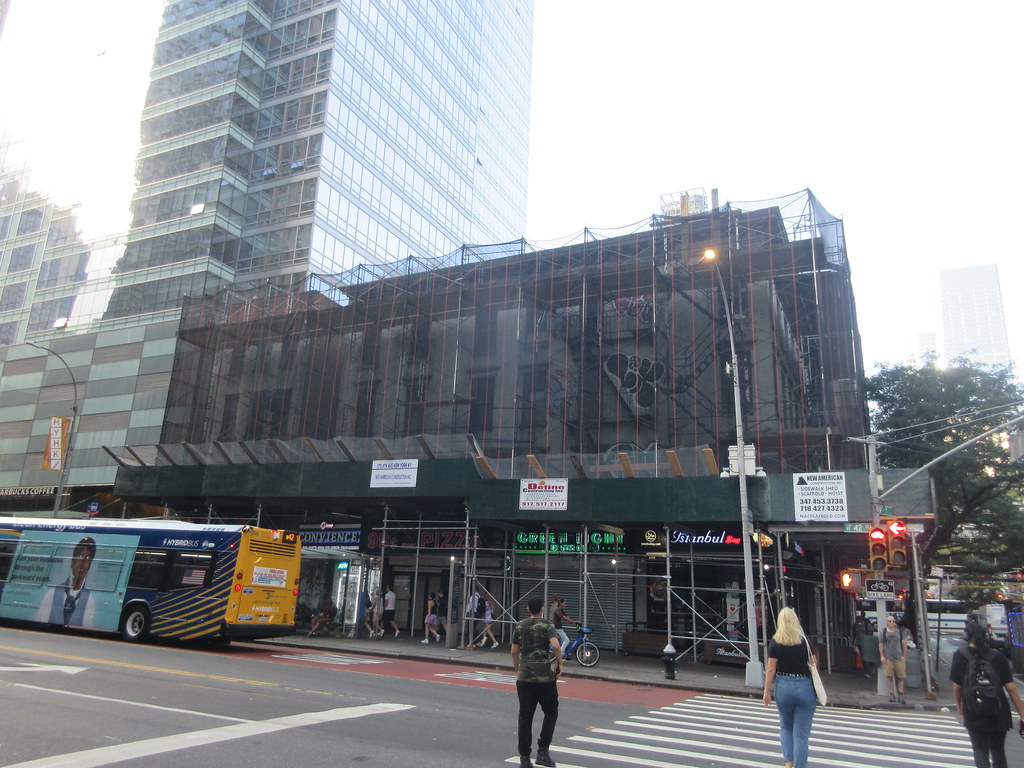Streamlining and Expediting the Use of Scaffolding & Sidewalk Sheds in NYC
Sidewalk sheds play an important role in keeping New Yorkers safe from falling debris and equipment on New York City streets. But across the city, these sheds, built to comply with local law inspection and repair requirements, are too often left up for months, or even years. Over 230 scaffoldings across the city have been up for over five years.
On average, sidewalk sheds are on city streets for 498 days, negatively impacting local businesses and neighborhood quality of life. Sidewalk sheds provide critical protection to pedestrians and their use remains essential in New York City. But we must be proactive in ensuring that they are up only for the duration of time required to perform needed work or inspection safely and not used to delay repairing dangerous façades.
Strategy 1: Provide support for buildings who need help getting work done quickly
Sidewalk sheds and scaffolding are erected to keep New Yorkers and workers safe, and will stay up as long as an unsafe condition exists on the side of a building. But some buildings struggle to complete work quickly, due to the availability of resources and materials, to financial trouble, or permitting complications. To address this, the MBPO proposes:
Provide low-interest loans to buildings struggling to complete façade work and comply with Local Law 11 requirements
Many times, sidewalk sheds that are up for a long time are a result of a building’s inability to afford extensive repairs. The State should pass legislation to allow the City to run a low-interest loan program for qualifying buildings with a demonstrated financial hardship – HDFCs, buildings participating in affordable home ownership programs, non-profits and rent regulated buildings – that provides financing for façade repair work as well as protections and prevailing wages for workers.
Create an accelerator program for property owners/boards struggling to make decisions about construction, financing, engineering, and LL11 compliance broadly
Construction, repair, financing, project management and compliance with the law can be complicated, and some property owners and boards lack the expertise to quickly and efficiently get work done. NYC DOB should launch an accelerator program that provides property owners and boards with access to expertise and guidance so that façade work can be done as quickly as possible.
Strategy 2: Reduce delays caused by permitting requirements and disputes with neighboring properties
Serious delays can be caused by permitting complications – particularly in historic districts – and by conflicts between neighboring property owners. These delays can set projects back months, or even years, meaning sidewalk sheds are erected but no work is actually done. To address this, the MBPO proposes:
Expedite façade permitting processes at Landmark Preservation Commission by expanding the staff available and dedicating a unit specifically to Local Law 11 compliance
Landmarked buildings and buildings in historic districts have to go to LPC before they go to DOB for permits. As a result, sidewalk sheds that are required for safety reasons are often erected well before façade work is even permitted to begin. Any delays at LPC and DOB could add many months to a project.
Allow property owners to petition for access to neighboring properties when necessary
The State should allow for mediated negotiation between property owners when access to neighboring properties is required, rather than court intervention. Conflicts between property owners can seriously delay the start of a project, but mediation could help ensure that façade inspections and repairs are done as quicky as possible so that scaffolding can be taken down
Strategy 3: Hold buildings accountable for failure to complete façade work in a timely manner
Some buildings choose to keep sidewalk sheds and scaffolding up rather than make necessary repairs. Others fail to get the appropriate paperwork, and others fail to complete work quickly for other reasons. These buildings should be better held accountable. To accomplish this, the MBPO proposes:
Create a task force to identify why the City is among the worst offenders of long term scaffolding deployment, and identify how to correct those challenges
The City is among the worst long-term scaffolding offenders. On average, sidewalk sheds are up for over a year on City-owned property, a truly unacceptable length of time.
Increase fines and civil penalties on buildings who fail to quickly complete work
DOB recently increased civil penalties, which resulted in improved in behavior from some problematic buildings. However, the borough remains buried in scaffolding, and those fine schedules should be increased again.
Exercise emergency powers to perform work on buildings that fail to correct unsafe conditions
DOB has the authority to direct the City to perform emergency work on unsafe buildings, the cost of which is added as a lien to the property. DOB should exercise this authority where buildings fail to correct unsafe facade conditions after a fixed period.
Create a program to assist tenants who suffer from long-term scaffolding deployment
Tenants living in buildings where scaffolding is deployed for an extended period of time may be entitled to rent abatements for decreased services. The City should provide support to rent-regulated tenants in filing for rent abatements and also offer support to market-rate tenants who withhold rent based on excessive scaffolding timeframes.
Strategy 4: Update Local Law 11 inspection regulations and reform design standards
Sidewalk sheds are a growing problem in New York City, and we need to reform both design standards and regulations to ensure neighborhood quality of life is maintained while also keeping pedestrians and workers safe. To accomplish this, the MBPO proposes:
Allow drones to be used for façade inspection
Drone technology could greatly improve the speed and efficiency of conducting façade inspections, but those drones are not allowed for Local Law 11 compliance. Introduction 452-2022, championed by Council Member Keith Powers, would allow for these technologies to be used, thereby providing a way for inspections to be conducted throughout the compliance period and help speed up the work Qualified Exterior Wall Inspectors must do.
Reform design standards to allow use of different designs and scaffolding types
The vast majority of sidewalk sheds and scaffolding utilize the same designs that have been in place for decades, while one company is allowed to use the popular but expensive “Urban Umbrella” style. DOB should reform design standards to allow for additional types of scaffolding and sidewalk sheds that could better fit the needs of local communities, including designs affixed to the side of a building as well as scaffolding that is higher above street level. Additionally, more companies should be allowed to utilize white paint, and reforms should be made to encourage better and brighter lighting.
Strategy 5: Extend Local Law 11 compliance cycles in certain instances
Buildings are required by Local Law 11 to be inspected every five years regardless of how much work has been done to the façade. This incentivizes buildings to do as little work as possible each cycle to keep costs down and still pass inspections.
Extend LL11 cycles by two years for buildings that complete major façade renovations
DOB should develop a program to allow buildings that undergo major renovation and façade work to go into a 7 year cycle immediately following renovations. This would encourage buildings to get extensive work completely done, and could reduce the need for sidewalk sheds to be erected in the following years.
Extend inspection schedules for new buildings made with lower risk materials
Not all buildings have the same risk of façade damage or deterioration, particularly new buildings made with materials other than terra cotta. The LL11 inspection cycle should be extended from 5 years to 7 for the first two inspection cycles after a building has been constructed.
Learn More About Manhattan’s Oldest Sidewalk Sheds
Click here or on the subheader above to check our our list of some of Manhattan’s oldest sidewalk sheds – and the awards we’ve given them for reaching their old age! CLICK HERE.
Downloads
How We Can Fix NYC’s Scaffolding Problem



